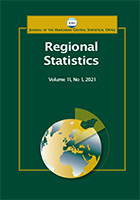Analysis of selected economic factor impacts on CO2 emissions intensity: A case study from Jordan, 1990–2015
Analysis of selected economic factor impacts on CO2 emissions intensity: A case study from Jordan, 1990–2015
Author(s): Mohammad M. JaberSubject(s): Social Sciences, Economy, Geography, Regional studies
Published by: Központi Statisztikai Hivatal
Keywords: energy intensity; climate change; causality analysis; path analysis; Jordan
Summary/Abstract: This study investigates the possible impacts of selected economic factors on carbon dioxide (CO2) emissions intensity in Jordan. The energy industry is one of the main sectors that have an impact on greenhouse gas emissions in Jordan, with a total share of 73% of emissions emanating from only this sector according to the 2006 emissions inventory. In this study, energy intensity, gross domestic product (GDP) per capita, labour force, and primary energy consumption are analysed using the Granger causality test and the pathanalysis for identifying the factors that mostly impact energy intensity vis-à-vis CO2 emissions intensity. The analysis is undertaken in order to study the changes in energy intensity and the possible impacts on CO2 emissions intensity. The results show that energy intensity has a direct impact on CO2 emissions intensity, as proven by both pathanalysis and the Granger causality test. Moreover, the most effective indirect path is that of running through the labour force, followed by the path that contains GDP per capita. In conclusion, while considering the necessity of Jordan’s economic development,there should be a focus on sustainability,improving technology, and supporting renewable energy projects.
Journal: Regional Statistics
- Issue Year: 12/2022
- Issue No: 01
- Page Range: 193-208
- Page Count: 16
- Language: English

